This costume was inspired by Tim Burton’s Film “Nine”. There were a lot of workarounds to make this costume, so measurements should be used as a guide. Also, it was made based on my body measurements. Hopefully, this will give you an idea of what process I went thru to create your costume and you can modify it to fit your needs.
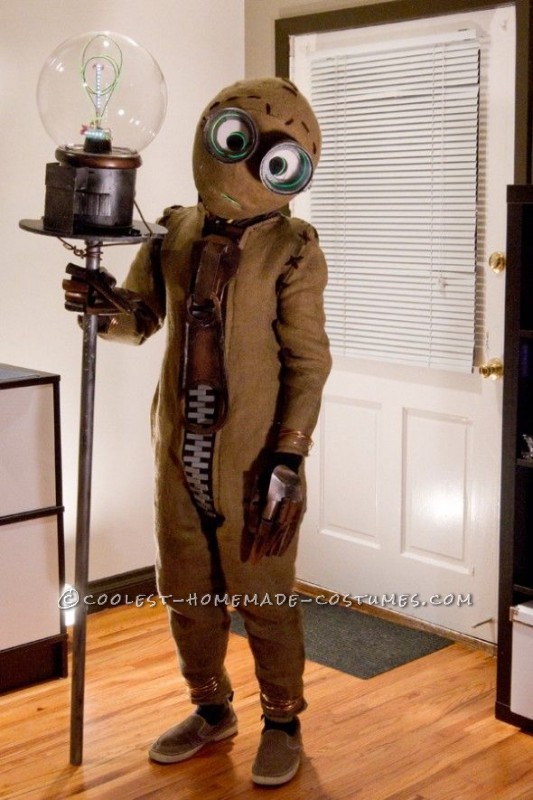
Head Base and Eyes
MATERIALS FOR THE HEAD:
– 2in. width strips of newspaper
– Tacky white glue.
– large round party balloon bigger than your head. This will be the base used to create the head for your costume. It must be large enough to fit your head.
– Something to suspend your balloon while you work on it. ( I used a camera tripod and string.)
– A brush to spread the watered-down glue.
– Lots of reference images of “Nine” front, side, top, views…
– Hot Glue Gun
– white base coat paint, Black, Reddish brown, copper and gold spray paint.
– Lightweight plaster.
– Fiberglass Resin
– Sand paper
– 1in foam brushes.
– Lots of basic brown cardboard. (I used cardboard from boxes and packaging.
The card board should have 3 layers. 2 smooth sides and a middle with air pockets. See Fig.a. You can base the thickness of the cardboard on the part you are using it for. Make sure there isn’t any slick coating or labels on it. This can cause the paint or plaster from adhering to the cardboard.)
– Compass with Xacto knife
– Burlap cloth
DIRECTIONS:
(Size up your balloon)
1. Inflate the balloon to a size that can fit your head.
(Prep your balloon for papermache)
2. Once you have the size of your head, prepare your balloon to be coated with newspaper. Get your tripod and tie one end of the string to the top of the tripod and the other end to the balloon tip. The balloon will dangle as you place the papermache.
(Create your paper strips)
3. Get a lot of newspaper and tear the paper into long strips about 1.5-2in thick. Set the paper aside.
(Make your paste)
4. Get a bowl and mix the glue with water till you get a milky consistency.
(Apply the newspaper strips)
5. This process will take some time and patience. Take one strip of newspaper and place it on top of the balloon and paint on the glue that you made over the strip, coating the entire strip. Repeat this process with another strip of paper, but place it across the previous strip, in a criss-cross pattern. This is important to create a weave of newspaper that will hold together. Work your way around the knot of the balloon and cover the entire balloon.
6. Once it becomes half-way dry, coat the entire balloon again with the strips in a criss-cross weave pattern. You will repeat this step 4-6 times to give your head a sturdy base. Once you are done let it completely dry. It should be sturdy and fairly hard. Pop the balloon and you should be left with a hard outer shell.
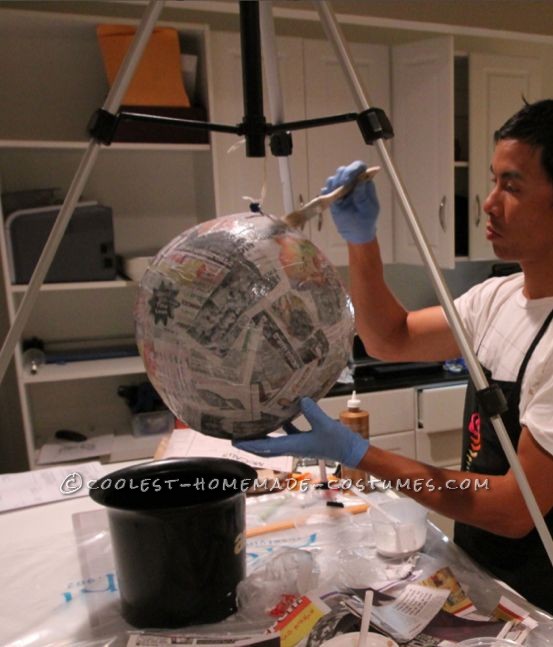
SHUTTER LENS EYES
MATERIALS FOR THE EYE:
– 0.5mm clear tubing
– lightweight plaster
– cardboard from boxes
– Resin
– clear acetate paper
– a dowel that’s 0.5mm diameter
– Hot Glue
1. The eyes are like a lens shutter. To break it down to simple shapes it’s a cylinder with a wider lip in the front. (See Fig:8c)
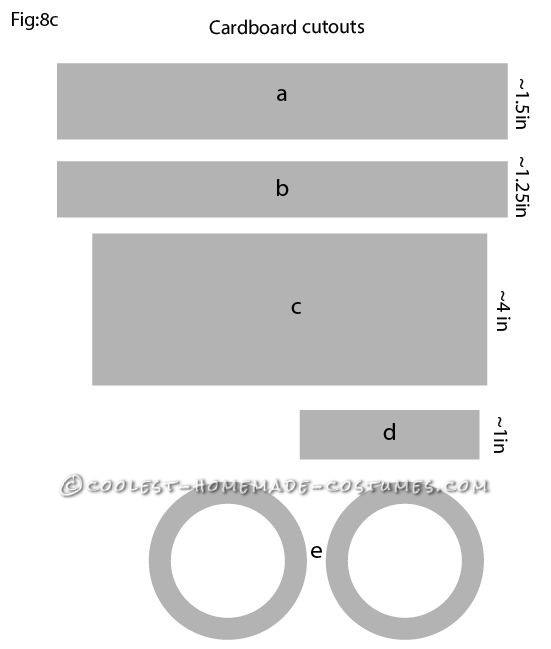
2. Cut a rectangular strip(b) of cardboard and wrap it around a cylindrical object. I used a pvc pipe about 5 in diameter.
3. Cut it so it perfectly butts up to the other end. When I was cutting the cardboard I left a layer of the cardboard paper in tact to attach to the other end.
4. Hot Glue it together to make a ring.
5. Cut strip(a) of cardboard and wrap it around strip(b).
6. Again, cut it so it perfectly butts up to the other end. Leave a layer of the cardboard paper in tact to attach to the other end. Hot Glue it together.
7. Hot Glue the outer ring cardboard(a) to the inner ring cardboard(b).
8.There should be a height difference from the inner ring to the outer ring that it creates a ledge inside the eye (See Fig.8a)
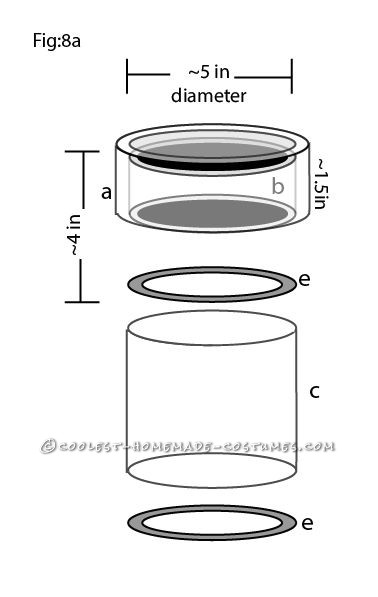
9. On the other end of the cylinder, attach an end piece cardboard(e) that’s the diameter of the hole. (See Fig 8a)
Your end piece is a circle with a smaller circle cut out of it.
10. Next wrap cardboard strip © around your pvc to create another cylinder.
11. Glue this piece onto cardboard(e)
12. Then finish up the piece with cardboard(e) at the end.
13. Cut cardboard strip (d) and attach it to the inner ledge inside the eye, out and over to the width of piece(a). (See Fig 8b)
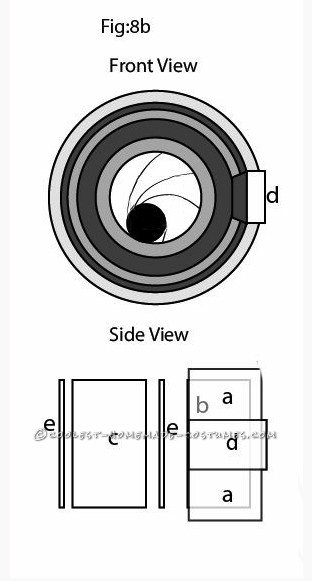
14. Cut a small piece of the wooden dowel, about 0.25in. Cut out a groove across the piece to resemble a screw.
15. Hot glue this piece on the side where you attached cardboard (d).
Smooth And fill up any imperfections to your Cardboard structure.
16. Using the lightweight plaster, you will smooth out imperfections or fill in any gaps of your cardboard construction. You can also use it to bevel or smooth out corners or edges.
17. Let the plaster dry and take a fine grit sand paper to smooth things out.
Create the camera shutter iris
18. Cut 5 identical circles from white card stock larger than the opening of cardboard(e). This cutout will sit behind the cardboard (e).
19. Glue all the circles on one side.
20. Cut a circle thru the 5 pieces you glued together to represent the eye. This will be the hole you will see out of, so make it large enough. Also, when cutting out your hole, make sure it doesn’t contain the area you used to glue the pieces together.
21. With an xacto knife, cut away each layer from the iris, staggering it so it looks like a camera shutter.
22. Set this piece aside. You will glue this once the eye piece is done.
Repeat this whole entire eye process for the second eye.
23. Once you have both eyes, map out where you will cut out the holes in your head that you will slide the eye pieces in.
24. Use a sharpie to trace your hole using your eye piece as a guide, on your head piece.
25. Cut out the hole from the head piece. Make sure to make the hole smaller than normal and remove a lil at a time so the eye piece has a snug fit.
26. After you have the eyes cutout, determine the position of the mouth and cut that out of your head as well.
27. Finally determine the opening of your head piece and cut out the back where you will place your head into.
28. Put the head piece on for a test fitting… if everything is kosher, then it’s time to coat the pieces with resin.
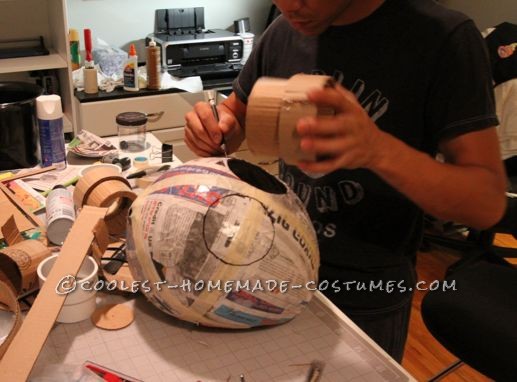
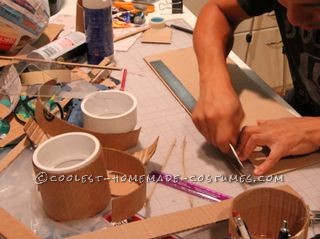
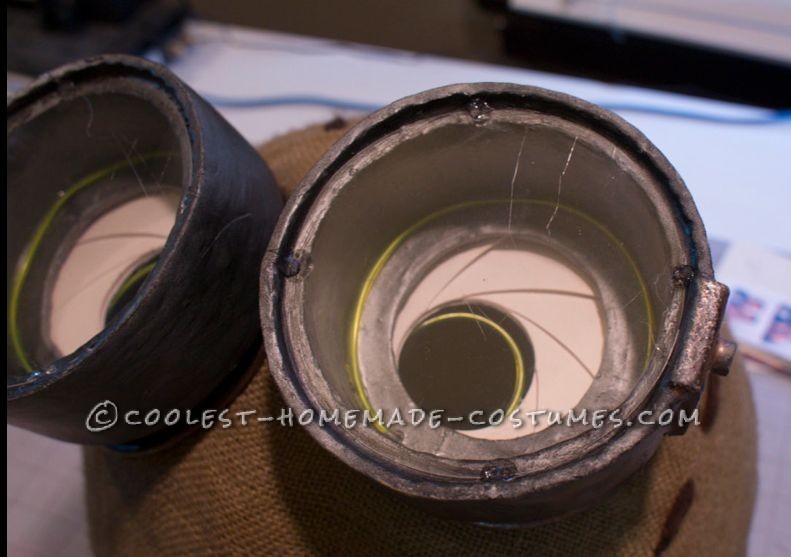
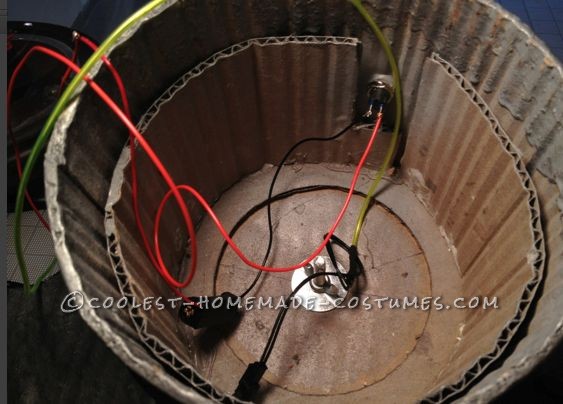
COATING THE HEAD AND EYES
1. Buy some Fiberglass resin from your local hardware store, and coat you eyes and head pieces with the resin. Be quick because the resin cures fast once you add the liquid hardener.
2. Let dry completely
3. Apply 2-3 coats
I would wear a mask or respirator because this stuff is strong smell’n and probably isn’t healthy to inhale the fumes for long periods.
PAINTING THE EYES
1. First, I painted the eyes with a matte white base coat.
2. I used a combination of 3 spray paints. Metallic Silver, Gold, and Black. This gave me the metal look.
3. First I coated the entire thing with silver.
4. I then used the gold in blending motion from the back to the front. This created a blending affect from gold to silver.. Overlapping the colors is the key to a great look.
5. I paint certain pats all gold for detail..
6. To add the dirty distressed metal, I sprayed a heavy amount of black and quickly wiped and smeared the paint off. This created streaks like groove marks and dents etc. I had plastic gloves so this was easy to do.
7. Once this has dried you can attach the iris you created with hot glue inside the eye piece, from the back.
CLOTHING THE HEAD
1. Once everything has dried, get the Burlap cloth and coat the entire head using the glue gun to affix the material to the base of the head.
2. Cut holes for any openings and fold the material into the opening.
3. Be conscious where continue pieces of material. The cloth stretches a lil but you’ll need to cut it, so it fits the head tight without any folds or gaps.
4. Once you are done with coating the head with fabric, get some brown yarn and a large sewing needle.
5. Start adding stitch marks on your head for detail. I created them above the eyebrows and the back of the head.
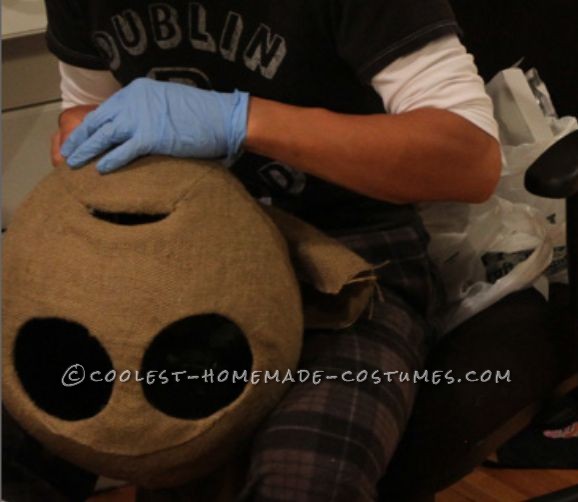
ATTACHING THE EYES TO THE HEAD
1. With your eyes finished slide them into the head and attach it using hot glue from the inside of the mask, so not to see the glue on the outside.
2. As a clever way to hide the seam from the eye to the head, I painted a piece of water tubing, a bronze color and wrapped it around the seam and attached it using hot glue for a cleaner look.
3. Once the eyes are in place I cut out 2 circles out of acetate paper to affix on the eyes to resemble glass from the lens.
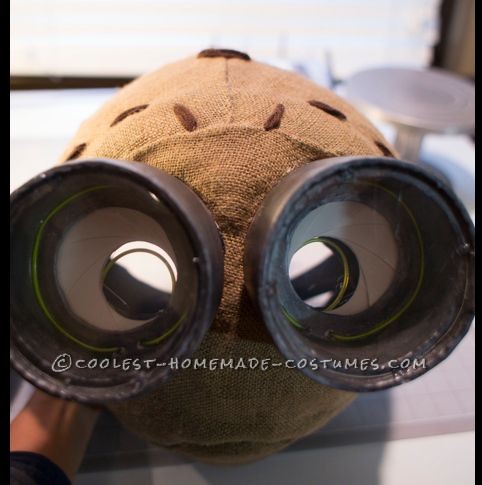
The Body
MATERIALS FOR THE BODY:
– Burlap cloth
– Brown yarn
– Black spray paint
– Sewing pattern for a typical animal costume for a guide.
– A long coat zipper to close up the costume
For the Zipper:
– cardboard
– 3 shades of metallic bronze spray paint and black
– silver spray paint for the zipper teeth
– fiberglass resin
– a darker piece of cloth for the zipper backing
– foam sheet for the zipper teeth
DIRECTIONS:
1. To create the body, I used a sewing pattern of an animal costume for the base. I used Mcalls costumes. You can find these online or at any fabric store.
I’ve never really used these templates before let alone sew, but it’s pretty much self explanatory. You buy the right size template to your body. Then you buy the material. Make sure to buy extra just in case.
Inside the packet are very delicate paper diagrams of all the pieces you need to create the costume. (i.e. leg, body,arms, etc.)
2. Open the packet and pull out the paper diagrams and cut out all the individual pieces based on your size.. Be sure to follow the packets instructions on where to cut.
3. Once you have all your pieces, spread out your cloth and pin all your paper templates to the cloth.
4. Next cut out all your pieces from the cloth. Also be careful with the paper diagrams because you will use them again for the reverse side.
Don’t forget to cut out the reverse side of the pieces. Your basically cutting out the front and back of the template.
5. Next, pin all your pieces together and measure it up to yourself. You can kind of slip the individual pieces on to see if you need to adjust it. The pins will be your guideline when you are sewing them together. Becareful of the needles.. I poked myself several times.
6. Once you have all the pieces pinned, start sewing them together. Plan out where you will have your opening to get into the costume. I placed my opening in the front chest area on the side of the large zipper where the dark material meets the burlap material. Sew one body part at a time. One thing to keep in mind is to make sure you have room in all your moveable parts.. shoulders, crotch, knees, etc. Better to have room now and bring in the stitch later. ALso, burlap is really itchy, so you might want to line the inside of your costume with a soft thin material. Basically, it’s duplicating the pieces that you cut and adding that in-between the layers you are sewing together.
7. Once you have all the pieces sewn together, put it on and bring in the fabric with needles where it needs to be tighter. I used this method to shape the costume to be wide at the hips and smaller at the top and bottom.. Almost like a pear shape. This is where all those shapes people talk about body types come from like hourglass, pear, etc.
8. Once the body costume is fitting correctly, you will need to map out where the large zipper will go.
9. There should be a large split down the middle of the costume in the front. This is where I told you where the opening would go so you would be able to get in and out of the costume. Draw with some chalk where the large fake zipper will go.
10. Pin back the burlap material and attach the darker piece of cloth on only one side of the burlap opening. The other side will be attached with the long coat zipper. Sew these elements together. This dark patch of material is the backing for the large fake zipper and the opening for you to be able to get in and out of your costume.
Adding The Fake stitches.
11. To add the fake stitches to the burlap, I used thick brown yarn and a large needle. This was easy… I created large X’s around the shoulders of the costume just to show detail and the illusion that the arm is being held by stitches.
Adding wear to the cloth.
12. When the body was all sewn, It looked too clean and neat… So I created some dirt on the costume using black matte spray paint. I gently spray areas of the costume that would normally get dirty the most.. these were the lower legs, forearms, knees, butt, etc. I gently sprayed the black. Then let it air out and dry for a day.
THE ZIPPER HANDLE
1. I created the actual zipper out of layers of cardboard that were glued together with hot glue. I used a 3d program(Maya) to model the zipper and then printed out the sides and used that as a template to cutout the cardboard. The program I used to print out the 3d model is (Pepakura). This allows you to print the individual sides of the 3d model for you to cut out and reassemble using paper.. But in my case I used the templates to trace onto cardboard to cut out.
2. Once I got my pieces together, I assembled the zipper using hot glue.
3. Next I used lightweight plaster to fill any holes or smooth out any edges, etc. Let the plaster dry.
4. Next, I coated the entire zipper with fiberglass resin and let dry for a couple of days.
5. After the piece was dry, I coated the zipper with a primer paint. Let dry. Then coat the entire zipper with a light bronze coat. Let dry..
To get this old metal look, I sprayed the next darker shade of copper and rubbed it while it was still wet revealing the color underneath. A rule of thumb, exposed areas are generally lighter and corners, crevices are dark.
THE ZIPPER TEETH
6. While that was drying, I got my foam sheet and cut 1″x2″in rectangles for the teeth of the zipper.
7. Once I cut all the teeth I sprayed that down with a metallic silver paint.. Let dry.
8. After I got all my zipper pieces, I attached it to my body suit down the dark cloth that I previously sewed on with hot glue. The fake zipper was attached at the top of the body suit with hot glue and reinforced to the suit with thread.
9. Next attach the silver rectangles, below the fake zipper with hot glue. Offset them.
You should now have a complete body suit.
Hands and Fingers
Materials for the fingers:
– thick card stock
– glue
– fiberglass resin
– 3 shades of metallic bronze spray paint and black
– old gloves
DIRECTIONS
1. For the hands I used an old pair of gloves and attached long fingers that I modeled to it… you can think of it like press on finger nails that women put on their nails.
2. In a 3d program, I modeled a fingers that I can build with paper using the “pepakura” program.
3. Once I created the fingers out of cardstock, I covered it with 3 coats of resin, sprayed it with a base coat and colored it bronze similar to the zipper.
4. Next I hot glued the fingers to the gloves.
The Light Staff
MATERIALS:
– The light was made mostly from cardboard that I modeled in a 3D program. I covered the cardboard replica with resin and painted it with the bronze paint similar to the zipper.
– The round dome is a plexiglass light fixture that I found online. This was the most difficult item to find. I search fish bowls, lighting fixtures, round bowls online and finally found on amazon.
– The details around the light are rubber tubes painted bronze and then wrapped around the cardboard model.
– The inside is a laundry detergent measuring cup that I painted the bottom half black.
– Attached to the laundry cup is a wire that I looped to resemble the inside of a light bulb.
– I lined the wire with led rope that is powered by a AA battery. The rope is attached to the wire by hot glue.
– The staff is made from PVC pipe and a pvc pipe cap is attached to the base of the cardboard light base with a washer and nut.
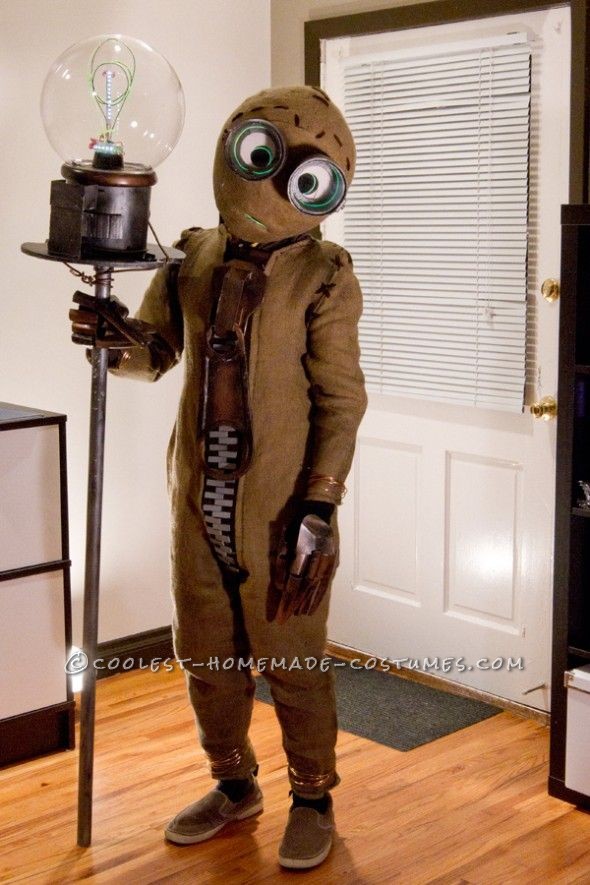
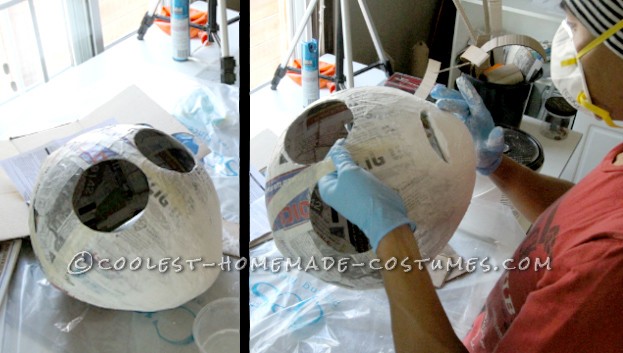
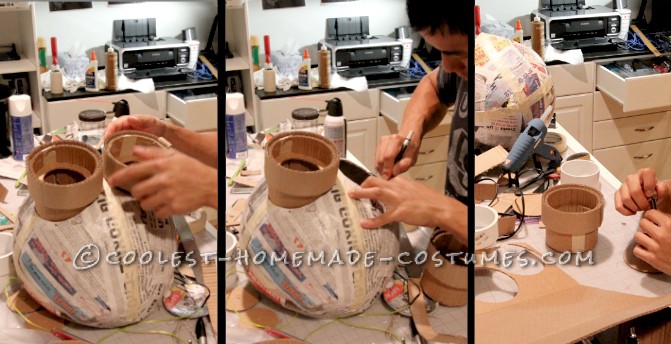
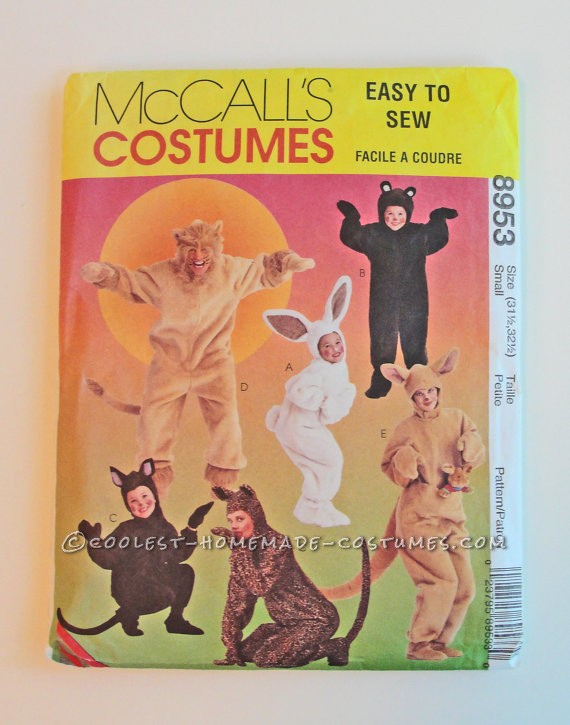

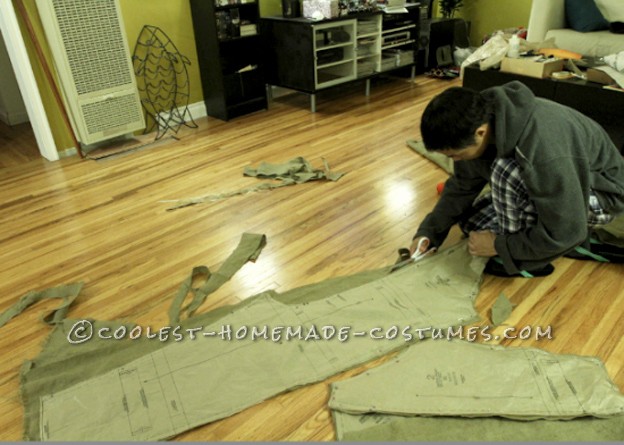
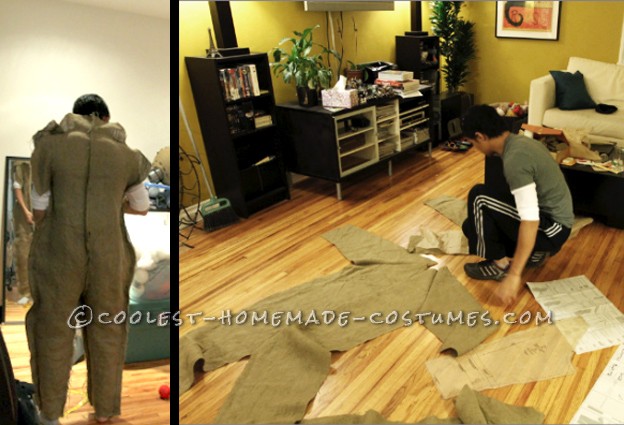
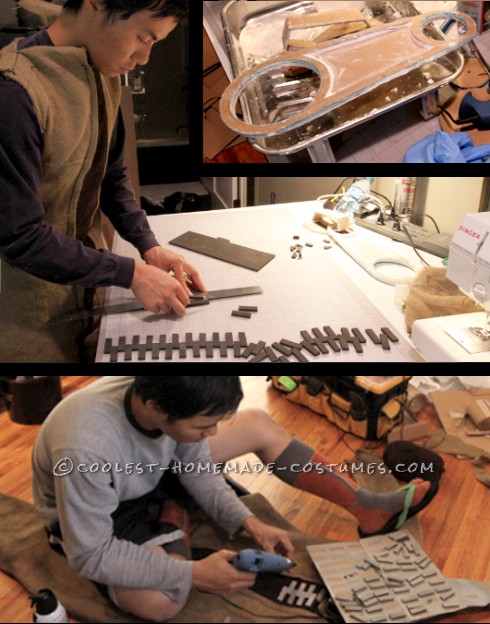
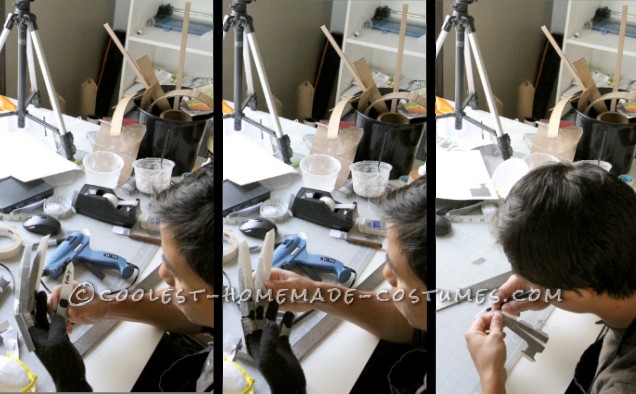
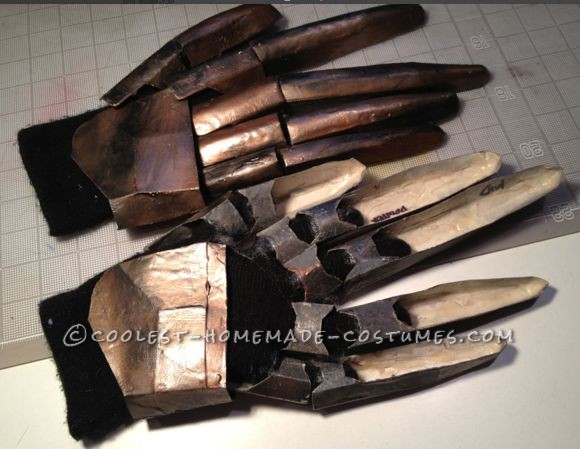
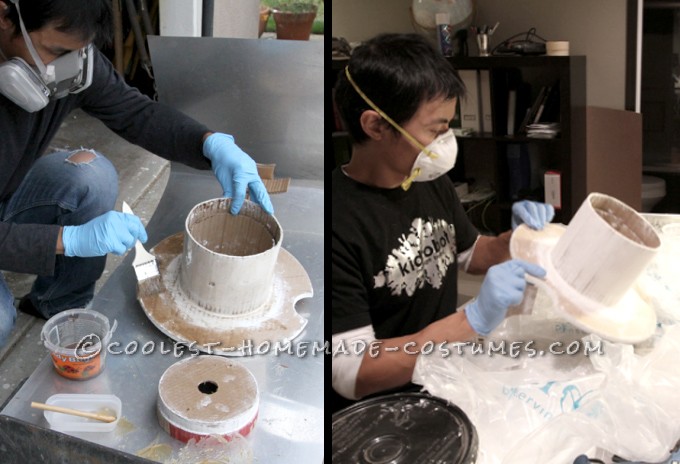
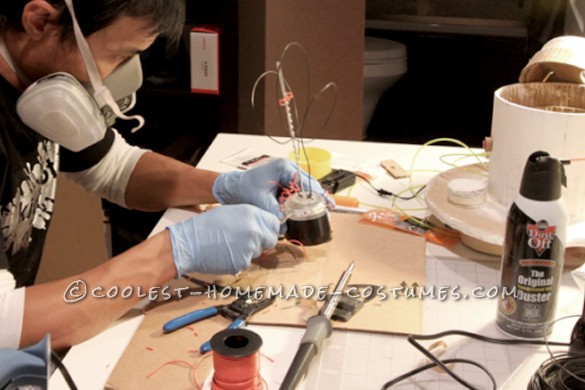
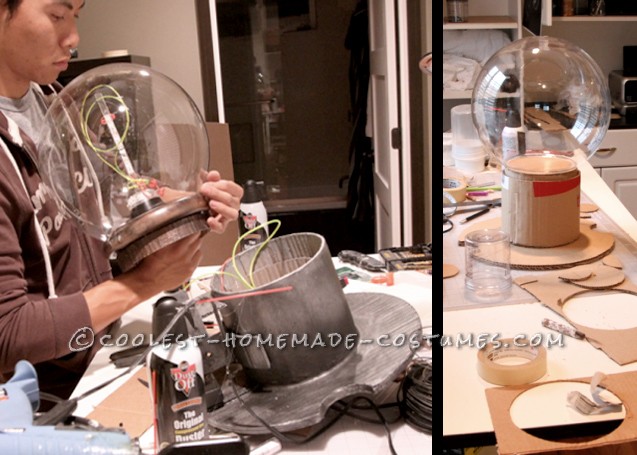
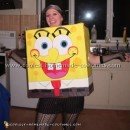
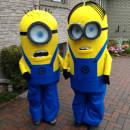
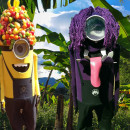
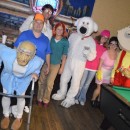
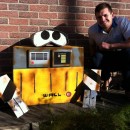
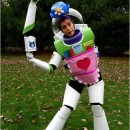
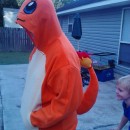
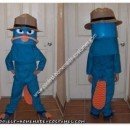
AWESOME! Dude, thumbs up!
Wow – You nailed it!
best costume ever!! Great job ..very impressed!! Are you a Tech theatre major?
nope.. just crafty.. Never even heard of that major… Where do you go to major in that?
Great costume. However, I have to chime in here to say that 9 was not a Tim Burton flick. It was directed by a fella named Shane Acker. :)
it was produced by tim burton
you are right tim burton did produce it… Shane Acker created a short film that was noticed at the sundance film festival. Tim burton slapped his name on it… Too bad the movie flopped.
Hello, are you interested in selling this costume or accepting a paid order to make another? I’d be interested either way. Let me know Branningrdb@aol.com
Thanks
SO AWESOME! I hope you won something for this!
Love, love, love homemade costumes…this is great! BUT I have a tip for all you paper mache folk…I’ve taught art for 22 years and the BEST/EASIEST material is a bottle of Liquid Laundry Starch. Pour it in a bowl and don’t use newspapers, use regular torn computer-printer paper–stuff that needs recycled, not new. Sticks much better and dries hard as a rock, and probably a little more lightweight than glue (or flour-ugh).
This is really great!!! now i know? what i want to do)) thanx for step by step instruction/ but also i woundering? do you have pepakura for hands??
How much did this all cost you?
How many centimeters is the head? I’m trying to do